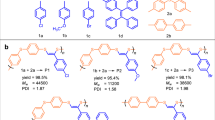Abstract
The electro-optic (EO) polymers of Y-type polyurethane-imides (PUI-1 and PUI-2) were synthesized by reaction of monomer azo-based chromophores, phenyl diisocyanate and aromatic dianhydride, based on polycondensation mechanism. Molecular structure characteristics for the polymers were evidenced by 1HNMR, FTIR, elemental analysis and gel permeation chromatography. The polymers exhibited a glass transition temperature (Tg) of 185 °C and 192 °C and a temperature of 5% weight loss at 256 °C and 325 °C and showed EO coefficient, γ33, of 43 pm/V and 51 pm/V at 1550 nm wavelength. A type of single-mode embedded PUI polymeric inverted rib waveguide Mach-Zehnder (MZ) interferometer electro-optic modulators was fabricated and measured, and exhibiting favorable electro-optical modulation response and the average propagation loss of the waveguide was less than 2.0 dB/cm at 1550 nm. The experimental results indicated that the PUI were promising candidates for the preparation of comprehensive performance excellent EO polymer waveguide materials, due to their large nonlinear optic effects, thermal stability, good processability and low optical propagation loss.










Similar content being viewed by others
References
Sun J, Chen CM, Gao L, Sun XQ, Gao WN, Ma CS, Zang DM (2009) Polarisation- insensitive strip-loaded waveguide for electro-optic modulators and switches. Opt Commun 282:2255–2258
Feng Q, Andrew MS, Daisuke M, Masaaki O, Keisuke O, Isao A, Akira O, Shiyoshi YA (2014) Straightforward electro-optic polymer covered titanium dioxide strip line modulator with a low driving voltage. Appl Phys Lett 105:073305–073304
Larry D, Stephanie B (2011) Theory-guided Design of Organic Electro-Optic Materials and Devices. Polymer 3:1325–1351
Sebastian K, Robert P, Matthias L et al (2015) Femtojoule electro-optic modulation using a silicon–organic hybrid device. Light: Sci Appl 4:1–8
Seo BJ, Kim S, Bortnik B et al (2009) Optical signal processor using electro-optic polymer waveguides. J Lightwave Technol 27:3092–3106
Zhang XL, Li M, Shi ZS et al (2011) Novel photo-cross-linkable polymer bearing spindle-type chromophores for second-order nonlinear optical materials. J Mater Sci 46:4458–4464
Lu J, Yin J (2003) Synthesis and characterization of photo-crosslinkable, side-chain, second-order nonlinear optical poly(ester imide)s with great film-forming ability and long-term dipole orientation stability. J Polym Sci Part A Polym Chem 41:303–312
Lee JY, Kim JH, Jung WT, Park YK (2007) Synthesis and nonlinear optical properties of novel Y-type polyurethanes with high thermal stability of dipole alignment. J Mater Sci 42:3936–3943
Mori Y, Nakaya K, Piao X et al (2012) Large electro-optic activity and enhanced temporal stability of methacrylate-based crosslinking Hyperbranched nonlinear optical polymer. J Polym Sci Part A Polym Chem 50:1254–1260
Pereverzev YV, Gunnerson KN, Prezhdo OV et al (2008) Guest-host cooperativity in organic materials greatly enhances the nonlinear optical response. J Phys Chem C 112:4355–4363
Liu JL, Gao W, Kityk IV et al (2015) Optimization of polycyclic electron-donors based on julolidinyl structure in push-pull chromophores for second order NLO effects. Dyes Pigments 122:74–84
Qin AJ, Yang Z, Bai FL et al (2003) Design and synthesis of a thermally stable second-order nonlinear optical chromophore and its poled polymers. J Polym Sci Part A Polym Chem 41:2846–2853
Denise HB, Bruce EE, Wenkel L, Li XS, Dalton LR, Robinson BH (2011) Dielectric dependence of the first molecular Hyperpolarizability for electro- optic chromophores. J Phys Chem B 115:3505–3513
Joshua AD, Arumugasamy E, Philip AS et al (2008) Rational enhancement of second- order nonlinearity: Bis-(4-methoxyphenyl)hetero-aryl-amino donor-based chromophores: design, synthesis, and Electrooptic activity. J Am Chem Soc 130:10565–10575
Delwin LE, Stephanie JB, Jinsheng S et al (2014) Matrix-assisted poling of monolithic bridge-Disubstituted organic NLO chromophores. Chem Mater 26:872–874
Philip AS, Benjamin CO, Larry RD (2008) Advances in organic materials for optical modulation. J Lightwave Technol 26:2345–2354
Wang LD, Tang J, Li RZ, Zhang T, Tong L, Tang J, Xu L (2017) Synthesis and characterization of electro-optic polyurethane-imide and fabrication of optical waveguide device. High Perform Polymer 29:879–888
Wang LD, Tang J, Li RZ, Zhang T, Tong L, Tang J (2016) Synthesis and characterization of crosslinkable polyurethane-imide electro-optic waveguide polymer. App Phys A Mater Sci Process 122:1–9
Wang LD, Zhang T, Li RZ, Zhang XY, Song YJ (2015) Synthesis and characterization of crosslinkable fluorinated polyimide for optical waveguide. App Phys A Mat Sci Process 118:655–664
Chao TY, Chang HL, Su WC et al (2008) Nonlinear optical polyimide/ montmorillonite nanocomposites consisting of azobenzene dyes. Dyes Pigments 77:515–524
Lindsay GA, Guenthner AJ, Wright ME et al (2007) Multi-month thermal aging of electro-optic polymer waveguides: synthesis, fabrication, and relaxation modeling. Polymer 48:6605–6616
Yu JC, Cui YJ, Gao JK, Wang ZY, Qian GD (2009) Enhanced optical nonlinearity and improved transparency of inorganic-organic hybrid materials containing Benzimidazole chromophores. J Phys Chem B 113:14877–14883
Pan QW, Zhang ZY, Fang CS et al (2001) Synthesis and characterization of thiazolylazo chromophore for nonlinear optical applications. Mater Lett 50:284–286
Qiu L, Shen YQ, Hao JM et al (2004) Study on novel second-order NLO azo-based chromophores containing strong electron-withdrawing groups and different conjugated bridges. J Mater Sci 39:2335–2340
Acknowledgements
This work is supported by Scientific Research Foundation of Huainan Normal University under grant no.2016xj03zd, NSFC under grant number 61307066, 61450110442.
Author information
Authors and Affiliations
Corresponding author
Rights and permissions
About this article
Cite this article
Wang, LD., Tong, L., Sun, HY. et al. Synthesis and characterization of electro-optic waveguide material polyurethane-imides. J Polym Res 25, 47 (2018). https://doi.org/10.1007/s10965-018-1450-5
Received:
Accepted:
Published:
DOI: https://doi.org/10.1007/s10965-018-1450-5




